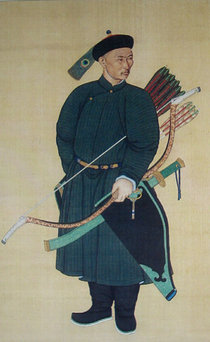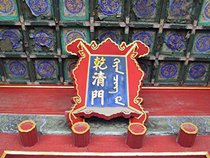Manchu
|
|
The Manchu (Manchu: Manju; Chinese: 滿族 pinyin: Mǎnzú; often shortened to 滿, Mǎn) are an ethnic group who originated in Manchuria. During the Manchu conquest, they conquered the Ming Dynasty in the 17th century and founded the Qing Dynasty, which ruled China until 1911. Manchu form one of the 56 nationalities officially recognized by the People's Republic of China.
Manchus have been largely assimilated by the surrounding Han Chinese and the Manchu language is almost extinct, being spoken only among a small number of elderly people. In recent years, however, there has been a resurgence of interest in Manchu culture among both ethnic Manchus (who are now essentially Han Chinese in all but name) and Han Chinese with some Manchu ancestry. The adoption of favourable policies towards ethnic minorities (such as preferential university admission and government employment opportunities) has also encouraged some people with mixed Han Chinese and Manchu ancestry to re-identify themselves as Manchu.
| Contents |
Origins
The Manchus were descendants of the Jurchen, who had conquered northeastern China in the twelfth century. The name was formally adopted by Nurhaci of the Jianzhou Jurchens in 1635, although it may have been used as early as 1605. Nurhaci's son Hong Taiji decided they would call themselves Manchus and prohibited the use of the name Jurchen. The early significance of the term has not been established satisfactorily, although it seems that it may have been an old term for the Jianzhou Jurchens. One theory claims that the name Manchu came from the Bodhisattva Manjusri (the Bodhisattva of Wisdom), of which Nurhaci claimed to be an incarnation. Before the seventeenth century, the ancestors of the Manchus were generally a pastoral people, hunting, fishing and engaging in limited agriculture. The Manchu language is a member of the putative Altaic language group, and is hypothetically related to Korean, Mongolian and Turkic languages.
 One of the Qianlong Emperor's Manchu bodyguards (1760) |
Founding of the Qing Dynasty
In 1616 a Manchu leader, Nurhaci (1559-1626) established the Later Jin Dynasty (後金 Hòu Jīn) / Amaga Aisin Gurun, domestically called the State of Manchu (manju gurun), and unified Manchu tribes, establishing (or at least expanding) the Manchu Banner system, a military structure which made their forces quite resilient in the face of superior Chinese numbers in the field. In 1636 Nurhaci's son Hong Taiji, headed by Manchus, Mongolians and Chinese, changed the dynasty's name to Qing.
When Beijing was captured by Li Zicheng in 1644, the Qing Empire invaded China proper and moved the capital from Mukden (Chinese city since the Warring States Period) to Beijing.(Nurhaci conquered nearby area and built a new city in 1621, and the new city is different from the original Chinese city Mukden!)
For political purposes, the early Manchurian emperors took wives descended from the Mongol Great Khans, so that their descendants (such as the Kangxi Emperor) would also be seen as legitimate heirs of the Mongolian Yuan dynasty. During the Qing Dynasty, the Manchu government made efforts to preserve Manchu culture and the language. These efforts were largely unsuccessful in that Manchus gradually adopted the customs and language of the surrounding Han Chinese and, by the 19th century, spoken Manchu was rarely used even in the Imperial court. Written Manchu, however, was still used for the keeping of records and communication between the emperor and the Banner officials until the collapse of the dynasty. The Qing dynasty also maintained a system of dual appointments in which all major imperial offices would have a Manchu and a Han Chinese member. Because of the small number of Manchus, this insured that a large fraction of them would be government officials.
Near the end of the Qing Dynasty, Manchus were portrayed as outside colonizers by Chinese nationalists such as Sun Yat-Sen, even though the Republican revolution he brought about was supported by many reform-minded Manchu officials and military officers. This portrayal quickly dissipated after the 1911 revolution as the new Republic of China now sought to include Manchus within its national identity.
Manchukuo
In 1931, the Japanese created what was portrayed as a Manchu homeland known as Manchukuo. By this time Manchuria was overwhelmingly Han Chinese, and even among the Manchus, this project failed to generate much genuine interest. It was abolished at the end of World War II, with its territory incorporated back into China.
See Also
|
Chinese ethnic groups (classification by PRC government) |
|
Achang - Bai - Blang - Bonan - Buyei - Chosen - Dai - Daur - De'ang - Derung - Dong - Dongxiang - Ewenki - Gaoshan - Gelao - Gin - Han - Hani - Hezhen - Hui - Jingpo - Jino - Kazak - Kirgiz - Lahu - Lhoba - Li - Lisu - Man - Maonan - Miao - Monba - Mongol - Mulao - Naxi - Nu - Oroqen - Pumi - Qiang - Russ - Salar - She - Sui - Tajik - Tatar - Tu - Tujia - Uygur - Uzbek - Va - Xibe - Yao - Yi - Yugur - Zang - Zhuang |

